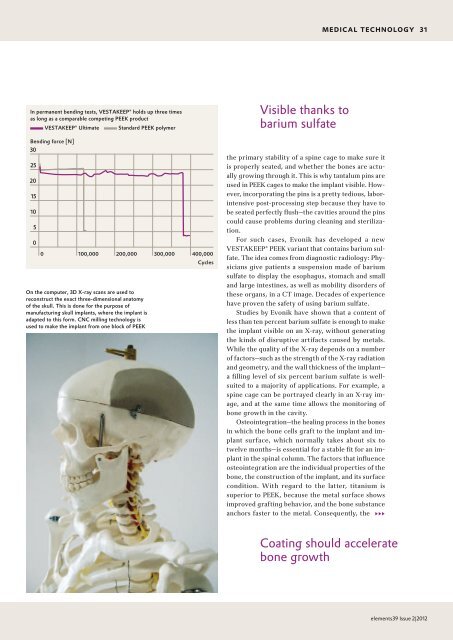Download - Evonik Industries
Download - Evonik Industries
Download - Evonik Industries
You also want an ePaper? Increase the reach of your titles
YUMPU automatically turns print PDFs into web optimized ePapers that Google loves.
In permanent bending tests, veStAKeeP® holds up three times<br />
as long as a comparable competing PeeK product<br />
veStAKeeP® Ultimate Standard PeeK polymer<br />
Bending force [n]<br />
30<br />
25<br />
20<br />
15<br />
10<br />
5<br />
0<br />
0 100,000 200,000 300,000 400,000<br />
Cycles<br />
On the computer, 3D X-ray scans are used to<br />
reconstruct the exact three-dimensional anatomy<br />
of the skull. this is done for the purpose of<br />
manufacturing skull implants, where the implant is<br />
adapted to this form. CnC milling technology is<br />
used to make the implant from one block of PeeK<br />
Visible thanks to<br />
barium sulfate<br />
MedICAL teCHnoLoGY<br />
the primary stability of a spine cage to make sure it<br />
is properly seated, and whether the bones are actually<br />
growing through it. This is why tantalum pins are<br />
used in PEEK cages to make the implant visible. However,<br />
incorporating the pins is a pretty tedious, laborintensive<br />
post-processing step because they have to<br />
be seated perfectly flush—the cavities around the pins<br />
could cause problems during cleaning and sterilization.<br />
For such cases, <strong>Evonik</strong> has developed a new<br />
VESTAKEEP® PEEK variant that contains barium sulfate.<br />
The idea comes from diagnostic radiology: Physicians<br />
give patients a suspension made of barium<br />
sulfate to display the esophagus, stomach and small<br />
and large intestines, as well as mobility disorders of<br />
these organs, in a CT image. Decades of experience<br />
have proven the safety of using barium sulfate.<br />
Studies by <strong>Evonik</strong> have shown that a content of<br />
less than ten percent barium sulfate is enough to make<br />
the implant visible on an X-ray, without generating<br />
the kinds of disruptive artifacts caused by metals.<br />
While the quality of the X-ray depends on a number<br />
of factors—such as the strength of the X-ray radiation<br />
and geometry, and the wall thickness of the implant—<br />
a filling level of six percent barium sulfate is wellsuited<br />
to a majority of applications. For example, a<br />
spine cage can be portrayed clearly in an X-ray image,<br />
and at the same time allows the monitoring of<br />
bone growth in the cavity.<br />
Osteointegration—the healing process in the bones<br />
in which the bone cells graft to the implant and implant<br />
surface, which normally takes about six to<br />
twelve months—is essential for a stable fit for an implant<br />
in the spinal column. The factors that influence<br />
osteointegration are the individual properties of the<br />
bone, the construction of the implant, and its surface<br />
condition. With regard to the latter, titanium is<br />
superior to PEEK, because the metal surface shows<br />
improved grafting behavior, and the bone substance<br />
anchors faster to the metal. Consequently, the 333<br />
Coating should accelerate<br />
bone growth<br />
31<br />
elements39 Issue 2|2012
















